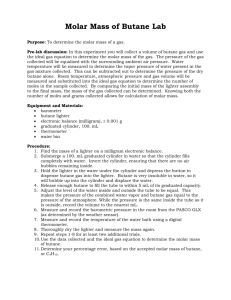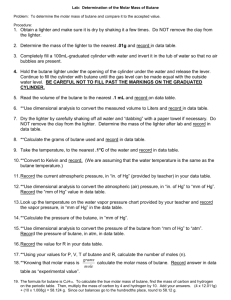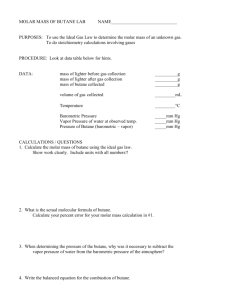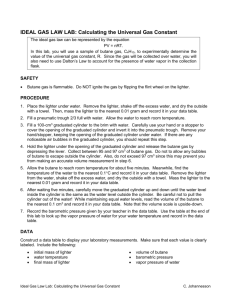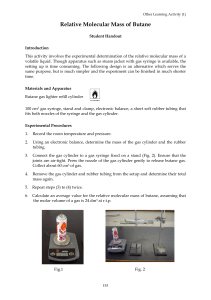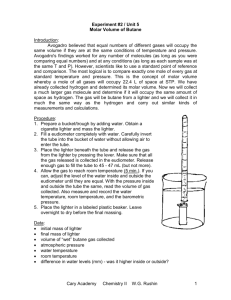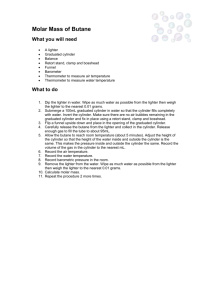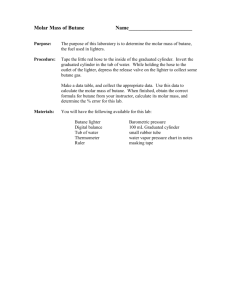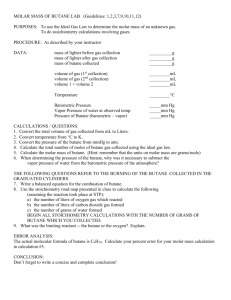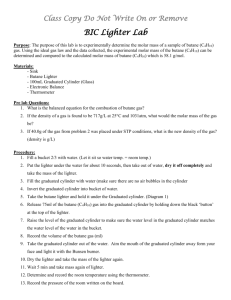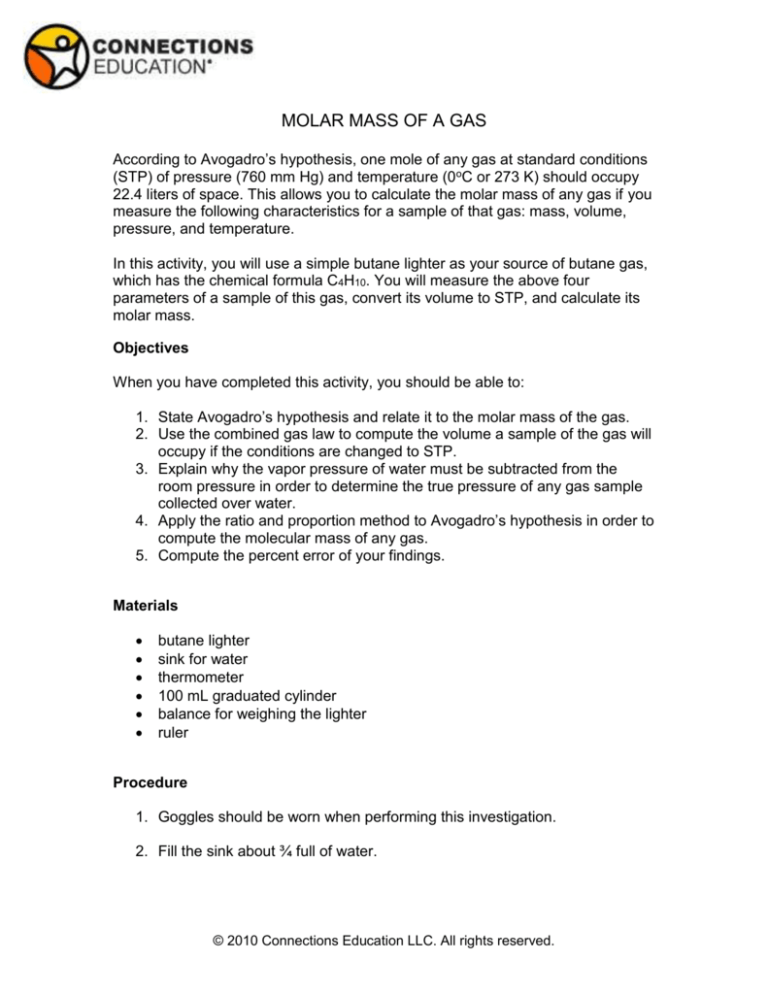
\
MOLAR MASS OF A GAS
According to Avogadro’s hypothesis, one mole of any gas at standard conditions
(STP) of pressure (760 mm Hg) and temperature (0oC or 273 K) should occupy
22.4 liters of space. This allows you to calculate the molar mass of any gas if you
measure the following characteristics for a sample of that gas: mass, volume,
pressure, and temperature.
In this activity, you will use a simple butane lighter as your source of butane gas,
which has the chemical formula C4H10. You will measure the above four
parameters of a sample of this gas, convert its volume to STP, and calculate its
molar mass.
Objectives
When you have completed this activity, you should be able to:
1. State Avogadro’s hypothesis and relate it to the molar mass of the gas.
2. Use the combined gas law to compute the volume a sample of the gas will
occupy if the conditions are changed to STP.
3. Explain why the vapor pressure of water must be subtracted from the
room pressure in order to determine the true pressure of any gas sample
collected over water.
4. Apply the ratio and proportion method to Avogadro’s hypothesis in order to
compute the molecular mass of any gas.
5. Compute the percent error of your findings.
Materials
butane lighter
sink for water
thermometer
100 mL graduated cylinder
balance for weighing the lighter
ruler
Procedure
1. Goggles should be worn when performing this investigation.
2. Fill the sink about ¾ full of water.
© 2010 Connections Education LLC. All rights reserved.
\
3. Lay a 100 mL graduated cylinder in the tray; allow it to fill completely with
water, and then hold it inverted and upright without allowing any air
bubbles into it.
4. Obtain a butane lighter. DO NOT LIGHT IT. Dry it as thoroughly as
possible by using a paper towel and by blowing forcefully around the flint
wheel and the release lever. Measure the mass of the lighter to the
nearest 0.01 g. Record this mass in the Data Table.
5. Carefully hold the butane lighter under the water so that the released gas
will go into the inverted graduated cylinder at the maximum rate until it
contains about 50 mL of gas. When you read the volume of gas in the
cylinder, make sure that the level of water inside the cylinder is the same
as the level of water outside. This step ensures that the pressure inside
the cylinder is the same as the atmospheric pressure outside the cylinder.
6. Remove the lighter and dry it thoroughly as you did before. Again,
determine its mass to the nearest 0.01 g and record this mass in the Data
Table.
7. Measure and record the temperature of the water in the sink. Use the
Internet to find the atmospheric pressure in the room.
8. Dispose of the butane in the cylinder by releasing it into the well ventilated
room.
DATA TABLE
Initial mass of butane lighter
g
Final mass of butane lighter
g
Volume of butane released
mL
Temperature of water
oC
Atmospheric pressure
mm Hg
© 2010 Connections Education LLC. All rights reserved.
\
Analysis
1. Since the gas in your graduated cylinder is a mixture of butane and water
vapor, you must determine the partial pressure of the butane, P butane,
alone. To do this, consult a reference and record the partial pressure of
the water vapor, Pwater, at the temperature you recorded. Use the following
formula to compute the partial pressure of the butane.
Pbutane = Atmosphere - Pwater
2. Use the following combined gas law formula and compute the volume that
the butane sample will occupy at STP. (HINT: Convert both temperatures
to Kelvin.)
Pbutane x Voriginal = Pstandard x Vfinal
Troom
Tstandard
3. Use the following ratio and proportion formula to determine the mass of
butane needed to occupy a volume of 22.4 L at STP.
Grams of butane you used
mL of butane corrected to STP
=
“X” grams of butane
22,400 mL
4. Compute the theoretical molar mass of butane based on its formula and
the atomic masses on the periodic table.
5. Compare your experimental results from #3 to the theoretical value of #4,
computing a percent error of your findings using this formula:
% error = measured value - accepted value x 100
accepted value
© 2010 Connections Education LLC. All rights reserved.

